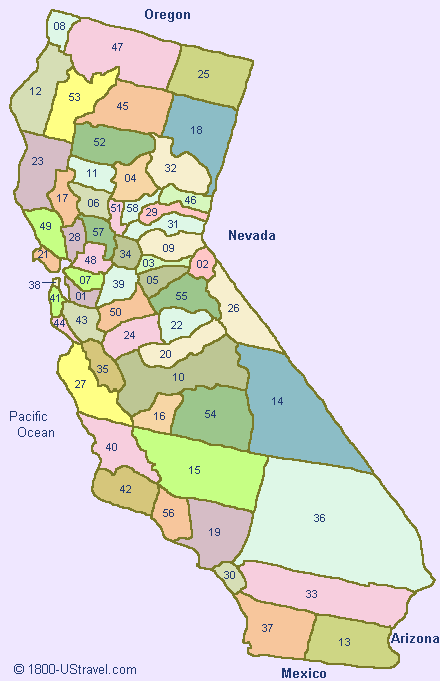California’s 58 Counties: History, Facts, and Travel Tips
California’s 58 Counties: History, Facts, and Travel Tips
Blog Article

Trying to find out how many counties California actually has? You’re certainly not the only one. Be it for research, a road-trip map, or pub-quiz glory, the number 58 keeps popping up, and stillthat short answeris just the first layer of a deeper tale.
This network of counties makes upa tapestry of extremes: fog-kissed seaside towns, high-elevation wilderness zones, fruit-laden interior valleys, and global entertainment capitals. Every county has a chapter in the state’s saga, moulded byimmigration waves, cutting-edge innovation, and relentless population booms.
Over the next few pages, we’ll unpackhow the state’s county map froze at fifty-eight, what each county actually does for its residents, and the record-holders—from the tiniest to the most populous. Ultimately, you’ll have the numbers—and map your next California adventure with confidence.
How the Golden State Reached 58 Counties
Upon admission to the United States, the map looked nothing like today’s. Rapid gold-rush immigration forced lawmakers to redraw borders. By the end of the 1870s, the count had ballooned to over five dozen counties, and in 1907 the final five were added, locking in the canonical figure of fifty-eight.
Legislative records show that most new counties stemmed from a trio of factors:
- Hundreds of rugged miles turned routine business into week-long trips.
- Economic clashes between miners and farmers ignited partition drives.
- Language and immigrant communities wanted self-rule.
In less than seventy years, the political map settled. In modern times, no proposal to add a 59th county has cleared committee, leaving historians to label the era of county creation a finished chapter.
Landscape and Climate Diversity Across California Counties
Stretch a string from rugged Del Norte on the Oregon line to sun-baked Imperial touching Mexico, and you’ll cross every Köppen zone short of tundra. Coastal counties enjoy fog-cooled summers, while great agricultural belts battle drought cycles.
- Sierra jurisdictions such as Mono, Mariposa, and Calaveras store California’s snowpack.
- Sacramento–San Joaquin fringe counties fight subsidence but export produce worldwide.
- Channel-coast administrators like Ventura manage marine sanctuaries.
Such variety explains the stark fiscal gaps between counties. Topography dictates everything from wage levels to weekend hobbies.
Behind the Scenes at the County Level
In California’s layered structure, cities tackle local bylaws, but counties are tasked with vital “unseen” duties that keep daily life humming. From birth to death—marriage licenses, tax rolls, voter registries—all reside at the county clerk or recorder.
County law-enforcement offices patrol vast rural stretches, website while trial courts hear civil suits. Social-services bureaus administer vaccination campaigns. Budget battles occur in monthly Board of Supervisors sessions.
Example: Contra Costa’s Shared Services Model
Tiny Alpine operates from a single two-story courthouse, showing how flexible the system is. One template doesn’t fit all when budgets span five figures to double-digit billions.
In the end, these 58 mini-capitols bridge Sacramento’s big laws and local reality. Grasping their portfolio empowers voters.
Population, Economy, and Record-Holding Counties
Home to over 39 million residents, but the headcount is far from evenly spread. Los Angeles County alone accounts for roughly a quarter. At the other extreme, remote Alpine rarely tops 1 200 inhabitants.
- Largest population: Los Angeles
- Fewest people: Alpine County
- Biggest footprint: San Bernardino County
- Tightest borders: City & County of SF
Fiscal bandwidth mirrors population spread. Tech-centric jurisdictions report six-figure median incomes, while cotton-and-almond hubs face commodity price swings. This revenue gap drive school funding debates every decade.
Memorising these records pays dividends: tax rates, job prospects, and lifestyle perks hinge on county lines.
An Epic 58-County Road Trip
Adventure-hungry drivers, bagging all 58 jurisdictions has become a badge. The classic route begins in San Diego, follows Highway 101 past surf towns, curves inland at Big Sur, then zigzags across nut groves and tomato fields, before climbing into the granite spine for ghost towns and mining museums.
Regional Mini-Loops
- Southern Swing – San Diego to Santa Barbara; 10 counties in four days.
- Heartland Stretch – Bakersfield up to the delta; eight hours of orchards.
- Lava Beds Detour – evergreen corridors; hidden hot springs.
Close the circuit in the desert southeast, with quadruple-digit odometer gains. After that, you can answer any road-trip quiz about county tallies—having grabbed selfies at every line marker.
Frequently Asked Questions
Wondering how the county system works? Start with these quick answers.
How many counties are in California?
State records confirm 58 counties—a number that hasn’t changed since 1907. Check any authoritative source, and you’ll find the same figure: precisely fifty-eight.
Most populous California county?
The population heavyweight is Los Angeles County, hosting a population greater than that of many U.S. states. Decades of immigration, entertainment dominance, and job growth keep the numbers high.
Least populous California county?
The crown for smallest population goes to Alpine County, rarely crossing the 1 200-resident mark. Its remote Sierra setting keeps growth modest, creating tight-knit communities.
What is California’s biggest county geographically?
The land-area giant is San Bernardino County encompassing deserts, mountains, and metro suburbs alike. Its sheer scale means climate zones shift from alpine snow to Mojave heat within county lines.
How did California end up with 58 counties?
Gold-rush politics, rail expansion, and farmland disputes carved today’s boundaries, with the final adjustments ratified in 1907. Since then, proposals to add a 59th county have surfaced but never cleared the Legislature.
Is it possible to form a 59th county?
Technically, the California Constitution leaves the door open, but the hurdles are steep. Petition drives, feasibility studies, dual-county referenda, and a two-thirds vote in Sacramento make secession rare. That’s why no county lines have moved since the early 1900s.
What services do California counties provide to residents?
Counties handle the backbone of local governance: property assessments, public hospitals, welfare programs, and jails. Their wide remit bridges state mandates with community needs, making the 58 jurisdictions essential to all Californians.
Report this page